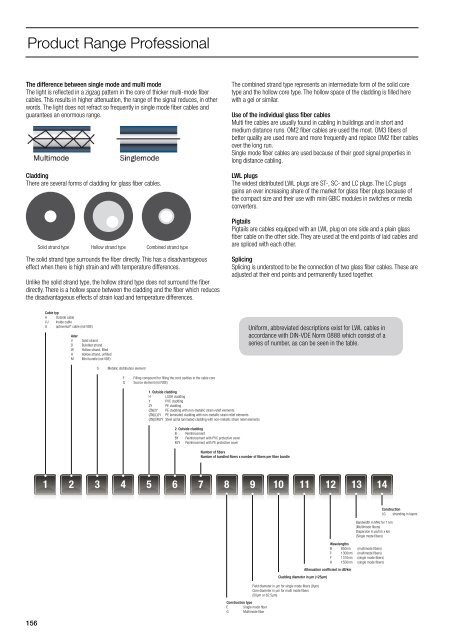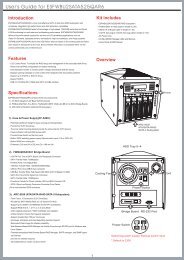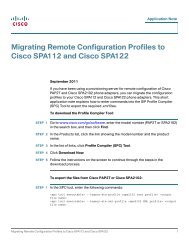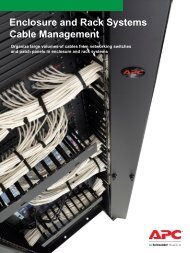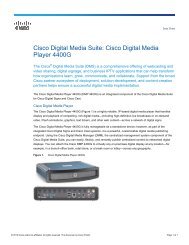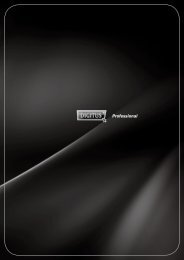NETWORK TECHNOLOGY - SWS a.s.
NETWORK TECHNOLOGY - SWS a.s.
NETWORK TECHNOLOGY - SWS a.s.
You also want an ePaper? Increase the reach of your titles
YUMPU automatically turns print PDFs into web optimized ePapers that Google loves.
Product Range Professional<br />
The difference between single mode and multi mode<br />
The light is reflected in a zigzag pattern in the core of thicker multi-mode fiber<br />
cables. This results in higher attenuation, the range of the signal reduces, in other<br />
words. The light does not refract so frequently in single mode fiber cables and<br />
guarantees an enormous range.<br />
Multimode<br />
Cladding<br />
There are several forms of cladding for glass fiber cables.<br />
Solid strand type<br />
Hollow strand type<br />
Singlemode<br />
Combined strand type<br />
The solid strand type surrounds the fiber directly. This has a disadvantageous<br />
effect when there is high strain and with temperature differences.<br />
Unlike the solid strand type, the hollow strand type does not surround the fiber<br />
directly. There is a hollow space between the cladding and the fiber which reduces<br />
the disadvantageous effects of strain load and temperature differences.<br />
The combined strand type represents an intermediate form of the solid core<br />
type and the hollow core type. The hollow space of the cladding is filled here<br />
with a gel or similar.<br />
Use of the individual glass fiber cables<br />
Multi fire cables are usually found in cabling in buildings and in short and<br />
medium distance runs. OM2 fiber cables are used the most. OM3 fibers of<br />
better quality are used more and more frequently and replace OM2 fiber cables<br />
over the long run.<br />
Single mode fiber cables are used because of their good signal properties in<br />
long distance cabling.<br />
LWL plugs<br />
The widest distributed LWL plugs are ST-, SC- and LC plugs. The LC plugs<br />
gains an ever increasing share of the market for glass fiber plugs because of<br />
the compact size and their use with mini GBIC modules in switches or media<br />
converters.<br />
Pigtails<br />
Pigtails are cables equipped with an LWL plug on one side and a plain glass<br />
fiber cable on the other side. They are used at the end points of laid cables and<br />
are spliced with each other.<br />
Splicing<br />
Splicing is understood to be the connection of two glass fiber cables. These are<br />
adjusted at their end points and permanently fused together.<br />
Cable typ<br />
A Outside cable<br />
I/J Inside cable<br />
U optoversal ® cable (not VDE)<br />
Ader<br />
V Solid strand<br />
D Bundled strand<br />
W Hollow strand, filled<br />
H Hollow strand, unfilled<br />
M Mini bundle (not VDE)<br />
Uniform, abbreviated descriptions exist for LWL cables in<br />
accordance with DIN-VDE Norm 0888 which consist of a<br />
series of number, as can be seen in the table.<br />
S<br />
Metallic distribution element<br />
F<br />
Q<br />
Filling compound for filling the cord cavities in the cable core<br />
Source element (not VDE)<br />
1. Outside cladding<br />
H LSOH cladding<br />
Y PVC cladding<br />
2Y PE cladding<br />
(ZN)2Y PE cladding with non-metallic strain relief elements<br />
(ZN)(L)2Y PE laminated cladding with non-metallic strain relief elements<br />
(ZN)(SR)2Y Steel spiral laminated cladding with non-metallic strain relief elements<br />
2. Outside cladding<br />
B Reinforcement<br />
BY Reinforcement with PVC protective cover<br />
B2Y Reinforcement with PE protective cover<br />
Number of fibers<br />
Number of bundled fibers x number of fibers per fiber bundle<br />
1 2 3 4 5 6 7 8 9 10 11 12 13 14<br />
Field diameter in μm for single mode fibers (9µm)<br />
Core diameter in μm for multi mode fibers<br />
(50µm or 62.5µm)<br />
Construction type<br />
E Single mode fiber<br />
G Multimode fiber<br />
Bandwidth in MHz for 1 km<br />
(Multimode fibers)<br />
Dispersion in ps/nm x km<br />
(Single mode fibers)<br />
Wavelengths<br />
B 850nm (multimode fibers)<br />
F 1300nm (multimode fibers)<br />
F 1310nm (single mode fibers)<br />
H 1550nm (single mode fibers)<br />
Attenuation coefficient in dB/km<br />
Cladding diameter in μm (125µm)<br />
Construction<br />
LG stranding in layers<br />
156


